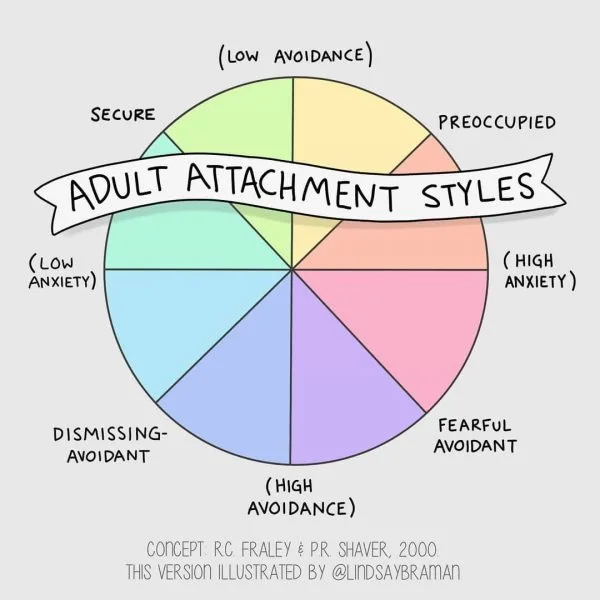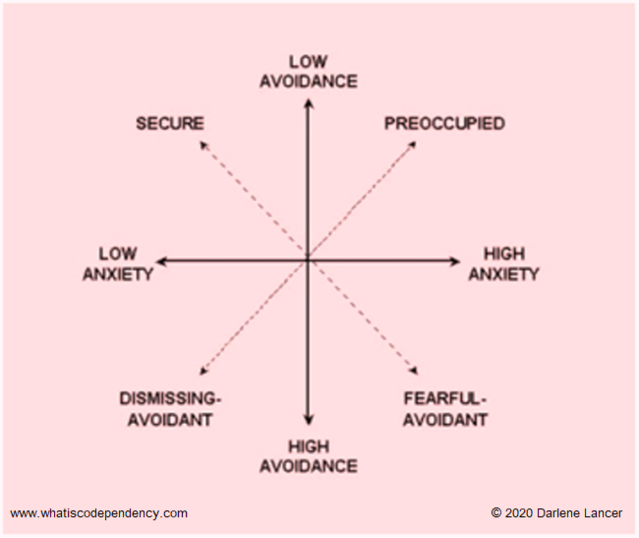That is early. Secure attachment avoidant attachment and ambivalent attachment Wallin 2007.

Understanding Adult Attachment Styles Illustrated Guide Lindsaybraman Com
The Four Attachment Styles Developmental psychologist Mary Ainsworth categorized attachment styles into three distinct patterns.

. Attachment styles comprise cognitions relating to both the self Am I worthy of love and others Can I depend on others during. Anxious also referred to as Preoccupied Avoidant also referred to as Dismissive Disorganized also referred to as Fearful-Avoidant Secure Before getting into what characterizes the four groups it might be useful to point out how attachment styles develop in children. They can cycle back and forth with an ambivalent style and an avoidant style.
Ad Browse Discover Thousands of Medical Book Titles for Less. This questionnaire study of the 324 partners from 162 romantic and marital relationships examined attachmentstyle differences in reported use of relational maintenance strategies. Next follows by insecureunhealthy attachment styles.
All but one of the 16 scalesPragma yielded significant attachment style differences. They seek out social support and have an ability to share feelings with other people Hazen Shaver 1987. Secure - Secure attachment is typically exhibited by a comfort with building relationships or having independence.
Consider the attachment style they adopt in therapy Compare current perceptions and feelings with those experienced in childhood Understand that their distorted perception of themselves and others may be outdated and unhelpful Verbalize their separation anxieties concerned with being without the therapist. The results suggest that attachment styles are important in explaining decision-making in romantic relationships that may be useful for research and practice focusing on romantic relationships. They want to be loved but believe they are too flawed.
They have a negative view of themselves. There are four adult attachment styles. The good news is that all styles can learn secure attachment skills for healthier relationships.
Secure Attachment people can depend on their partners and in turn let their partners rely on them which can be very beneficial in a relationship cause relationships need honesty tolerance and emotional closeness to be stable which is what Secure attachment is all about. The concept of attachment styles grew out the attachment theory and research that emerged throughout the 1960s and 1970s. Supports the tenets of adult attachment theory as first expounded by Hazan and Shaver 1987Thatisadultsclosepersonalrelation-ships share important emotional and behav-ioral similarities with the bonds that form between infants and caregivers.
Further the concept of attachment style applies to both types of relationships. Following is a questionnaire designed to measure your attachment stylethe way you relate to others in the context of intimate rela-tionships. Want to read the entire page.
This is often considered an unhealthy attachment style. Adult attachment styles describe peoples comfort and confidence in close relationships their fear of rejection and yearning for intimacy and their preference for self-sufficiency or interpersonal distance. Se-cure subjects obtained the highest scores on all three self-esteemscales and the lowest scores on Self.
SECURE AVOIDANT DISMISSIVE PRESENTING CHARACTERISTICS how an individual relates within the context of an adult relaonship AMBIVALENT PRE-OCCUPIED DISORGANIZED FEARFUL-AVOIDANT. We propose that attachment style is a precursor to high-quality supervisor- subordinate relationships. In adulthood attachment styles are used to describe patterns of attachment in romantic relationships.
This questionnaire is based on the Experience in Close Relationship ECR questionnaire. This attachment style will have a greater sense of making the right decisions in relationships including receiving and responding to love. One of Ainsworths students Mary Main went on to discover disorganized attachment Wallin 2007.
Illustration by Jessica Olah Verywell What Is. Men obtained higher scores on Loving Agape andReliance on Partner and Women scored more highly on Friend-ship and Obsessive Preoccupation. Still both anxious and avoidant attachment are associated with heightened stress within the couple Donarelli et al 2012 while a secure attachment style would instead play a protective role.
This is often considered a healthy attachment style. Adults who are low in anxious and avoidance styles tend to have trusting long-term relationships. Today psychologists typically recognize four main attachment styles.
According to the theory there are four types of attachment styles. Secure avoidant aka dismissive or anxious-avoidant in children anxious aka preoccupied or. PDF Personality disorders PDs are commonly associated with romantic relationship disturbance.
The disorganized attachment style. AnxiousPreoccupied - Anxious attachment is typically exhibited by a dependence on relationships and other people. The ECR was first published in 1998 by Kelly Brennan Catherine Clark and Phillip Shaver the same Shaver who publ.
Attachment styles of relationship partners Allison Bartholomew Mayseless Dutton 2008.

Struggles And Strengths For A Dismissive Avoidant Attachment Styles Over Sensitive Struggling

Adult Attachment Styles Spectrum Lindsaybraman Com

Pdf The Relationship Between Attachment Styles And Employee Creativity Evidence From The Engineering Industry Semantic Scholar

How To Change Your Attachment Style And Your Relationships Psychology Today Canada



0 comments
Post a Comment